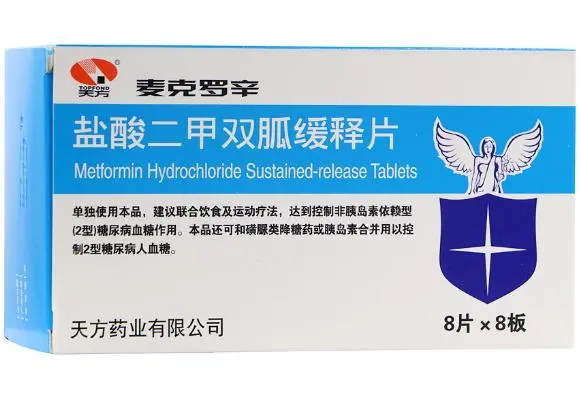Metformin Hydrochloride Sustained-release Tablets.
Function:
It is used for type 2 diabetes where diet and physical exercise alone are ineffective in controlling blood sugar. For the adjuvant treatment of insulin-dependent diabetes (type 1 diabetes).
Dosage:
This product should be started with a small dose and gradually increased according to blood sugar conditions. Please follow your doctor’s advice for details. The initial dose for type 2 diabetes (when used alone) is 0.5g once daily with dinner, and may be increased by 0.5g weekly. The maximum daily dose is 2g once a day. If 2g once a day (once a day) still does not achieve satisfactory efficacy, consider changing to 1g a time, twice a day. If a higher dose is needed, regular tablets of this medicine should be selected and the maximum daily dose of 2.55g should be used (taken in divided doses). Please follow your doctor’s advice for details. Type 2 diabetes (when used in combination with other drugs) and sulfonylureas: For patients who have not responded to metformin hydrochloride tablets at the recommended maximum dose for several weeks, consideration should be given to gradually adding sulfonylureas while maintaining maximum dose therapy. Urea drugs. If blood sugar cannot be controlled satisfactorily within 1 to 3 months, you should consider changing the treatment method, including using this drug in combination with insulin or insulin alone. Please follow your doctor’s advice for details. In combination with insulin: The dose of insulin can be maintained when starting this medicine. For patients using insulin, the initial dose of this drug is 0.5g once a day. If the effect is not satisfactory, increase the dosage by 0.5g after 1 week, and then increase by 0.5g every week until satisfactory blood sugar control is achieved. The recommended maximum daily dose is 2g. Please follow your doctor’s advice for details. The initial dose for polycystic ovary syndrome and anovulatory infertility is 0.5 g daily, followed by increasing the dose to 1 g daily, twice daily within 1-2 weeks. Please follow your doctor’s advice for details. For patients with renal insufficiency and a glomerular filtration rate (eGFR) greater than or equal to 60ml/(min·1.73m), no dose adjustment is required. If the eGFR is 45-59ml/(min·1.73m), the dosage should be reduced; please follow your doctor’s advice for details. If the eGFR is less than 45ml/(min·1.73m), it is prohibited. Others: Elderly people over 65 years old should adjust the dose according to their renal function due to weakened kidney function; patients with non-alcoholic fatty liver disease do not need to adjust the dose.
Adverse reactions:
Cardiovascular system: hot flashes, palpitations, unstable angina. Endocrine system: lactic acidosis, reduced absorption of vitamin B, hypoglycemia, weight loss. Respiratory system: difficulty breathing, upper respiratory tract infection. Musculoskeletal system: myalgia. Nervous system: headache, dizziness, etc. Liver: abnormal liver function, hepatitis. Gastrointestinal tract: nausea, vomiting, diarrhea, abdominal pain, anorexia, dysgeusia, bloating, indigestion, abdominal discomfort, abnormal stool, constipation, bloating, pancreatitis, etc. Blood: Coagulopathy; hemolytic anemia has been reported in individual cases. Skin: erythema, pruritus, urticaria, nail abnormalities, rash, hyperhidrosis; cases of lichen planus have been reported. Others: Fatigue, chest discomfort, chills, flu symptoms.
Drug contraindications:
If you are allergic to this product, it is contraindicated. It is contraindicated during pregnancy. It is contraindicated during lactation. It is contraindicated in patients with liver and kidney dysfunction. It is contraindicated in children.
Share:
Products
Our offers
Health Classification
Let us work together to protect precious health
































